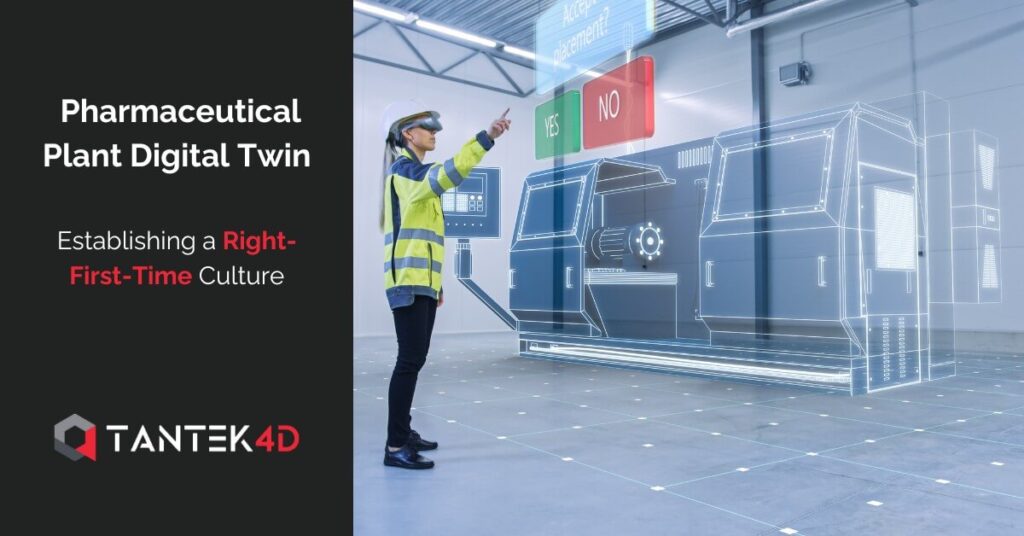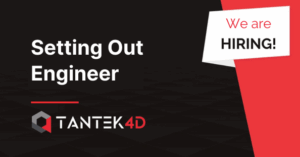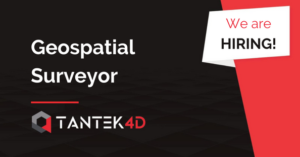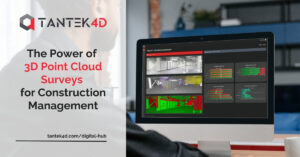There are a lot of potential applications for digital twin technologies in the pharmaceutical sector. Those applications include at the manufacturing process level as well as the product and patient level. In this blog, we are going to focus on another application for digital twins in pharmaceutical facilities – at the plant level. We are also going to focus on one key benefit/objective – establishing a right-first-time culture.
Before getting into those specifics, it is important to first demystify the digital twin topic as it is an area that is often presented with too much jargon, not enough real-world specifics, and very little focus on return on investment.
(For context, at Tantek 4d, we don’t do jargon, we are very much focused on real-world specifics, and return on investment is a core priority.)
Let’s start by defining digital twin technologies as they apply to pharmaceutical manufacturing facilities.
What is a Digital Twin?
A digital twin is a digital representation, often a 3D digital representation, of, in this case, a pharmaceutical manufacturing facility. It is more than a standard digital representation or 3D model that can be produced on a CAD programme, however. Instead, a digital twin is an interactive, information-enriched digital representation of your pharmaceutical plant that is updated in real-time using data from the facility.
That is a very high-level description as every digital twin is unique to the facility it represents, with varying features, components, and elements. But the description is a good starting point.
Overview of the Current Situation in Pharmaceutical Facilities
Your pharmaceutical manufacturing plant will have CAD drawings that will cover most, if not all, of the facility. You may also have 3D models of various areas and additional documentation/information for other elements.
While this information exists, it often presents as many problems as it solves.
For example, CAD drawings are likely to be construction drawings, so they won’t necessarily represent the as-built reality of your facility. As a result, levels of accuracy will be low. Also, any drawings you have almost certainly won’t be georeferenced.
The information you have may also be incomplete.
And some of it will exist in silos, where teams and departments are either unaware of its existence or find it hard to access.
This reality leads to delays, increased project costs, inefficient planning, increased H&S risks, double work and rework, unnecessary downtime, and avoidable errors. There can also be ongoing challenges, including higher-than-necessary maintenance costs and energy use.
Patient Safety, Compliance, Supply Chain, and Corporate Reputation
All the above challenges and negative impacts apply to any type of manufacturing facility, but there are additional risks for manufacturers in the pharmaceutical sector, including:
- Patient safety risks – there are many factors that can influence the quality and safety of products manufactured on your production lines, including facility and environmental factors (such as temperature or humidity) exceeding acceptable limits.
- Compliance – patient safety risks also increase compliance risks, plus the cost of maintaining compliance can be higher than necessary.
- Supply chain – a lack of accurate and complete as-built data can lead to unnecessary and unplanned downtime, impacting your supply chain, both upstream and downstream.
- Corporate reputation – all the above can have a significant impact on your reputation, leading to knock-on and potentially severe commercial, contractual, and legal challenges.
Establishing a Right-First-Time Culture
There are many benefits that a plant-level digital twin can bring to your company. A reduction in energy consumption, improved maintenance processes, and ensuring construction projects are completed on time are all examples.
The vast majority of these benefits can be summarised by the main driving factor for building a digital twin of your pharmaceutical manufacturing facility – establishing a right-first-time culture.
Here are some examples of what a right-first-time culture looks like:
- Right-first-time monitoring – real-time, accurate environmental data covering all parts of your facility, especially your factory floor and laboratory.
- Right-first-time project delivery – accurate, as-built data that can be made available to all stakeholders during maintenance, repair, improvement, modernisation, extension, or change of use projects.
- Right-first-time planning – assessing the viability of projects and infrastructure changes without the need to even be on-site.
- Right-first-time decision-making – accurate and complete as-built data lets you move away from guesswork and best estimate decision-making.
- Right first-time sustainability progress analysis – accurate, real-time information on key sustainability and ESG metrics, including carbon footprint, energy use, water use, etc.
From major infrastructure projects to the day-to-day management of your pharmaceutical facility, a right-first-time culture is the major advantage of digital twin technologies.
A Right-First-Time Culture and Return on Investment
Getting projects, decisions, cost estimates, plans, etc right first time will deliver a fast return on your investment in digital twin technologies. Furthermore, those returns will multiply over time as the digital twin continues to add value to your facility management function and overall operations.
From small savings (such as avoiding double work) to medium-level savings (such as projects finishing on time and within budget) to potentially significant savings (such as avoiding unplanned production line downtime), digital twins repeatedly pay for themselves.
Digital twins also present minimal, if any, risks to pharmaceutical manufacturing facilities as the technologies and skills required to produce highly detailed and accurate real-time models not only exist but are proven. The era of the digital twin in pharmaceutical facilities management is now.




